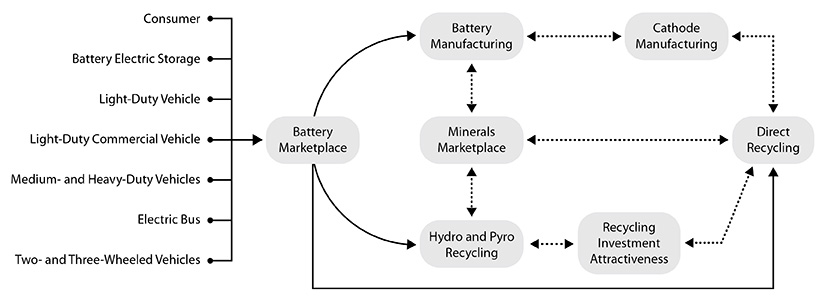LIBRA: Lithium-Ion Battery Resource Assessment Model
The Lithium-Ion Battery Resource Assessment Model (LIBRA) provides critical insight into lithium-ion (Li-ion) battery manufacturing, reuse, and recycling across the global supply chain under dynamic conditions.
Developed at NREL with funding from the U.S. Department of Energy, LIBRA helps researchers determine how to build a resilient and robust supply chain and grow domestic manufacturing.
LIBRA in Action
LIBRA explores the technological advances and market signals that could affect global supply chains for raw materials, primary and recycled batteries, and electric vehicles. LIBRA has demonstrated that the growing demand for Li-ion batteries presents opportunities for domestic manufacturing, recycling and re-use of critical materials, and global partnerships.
Additional key insights include:
- Investments and research progress necessary to grow the Li-ion battery recycling industry
- Importance of battery chemistry and sorting in the recycling supply chain
- Specific regional potential of recycling to offset mineral imports
- Economic and job opportunities supported by battery manufacturing and recycling.
NLR researchers have used LIBRA to support industry, academia, and government agencies to provide insights to strengthen the U.S. battery recycling supply chain.
Learn more about NLR's battery recycling analysis projects.
Framework and User Interface
LIBRA considers five electric vehicle types, consumer electronics, and stationary grid storage batteries to understand interconnections between battery manufacturers and market demands, including future applications and developments. LIBRA operates in a system dynamics framework, which considers the continued evolution of the battery and use markets. The tool also includes advanced feedback loops that inform calculated changes throughout the stages of the supply chain.

NLR researchers have designed an online interface to allow public users access to essential inputs and outputs from the LIBRA model. The online interface includes 12 screens for background and assumptions, inputs, results, and scenario evaluation and allows users to change parameters and quickly see their combined impact on the model outputs. In addition, the LIBRA interface can quickly run different scenarios and compare results for further evaluation.
Within the online interface, users can modify battery demand, lifetime, and chemistries to illustrate potential future scenarios that can inform policy and infrastructure investments needed to develop a domestic and robust supply chain. In addition, LIBRA can consider manufacturing impacts, such as plant finances, investment subsidies, material prices, logistic costs, and efficiency.
Critical Parameters
NLR researchers designed LIBRA to include these critical parameters to allow stakeholders to clarify how different variables affect outputs through sensitivity studies:
Battery chemistry changes
Battery sorting
Policy impacts
Inclusion of consumer electronics in the recycling stream (i.e., collection and sorting efforts)
Piloting new technologies (industrial learning)
Impact of manufacturing scrap on recycling economics
Mineral prices
Storage time for end-of-life batteries (stockpiling)
Manufacturing and recycling process yield
Electric vehicle implementation estimates.
Contact
Contact NREL's analysis experts with any questions about the LIBRA model.
Lead, Supply Chain and Electric Vehicle Storage Analysis
Share
Last Updated Dec. 6, 2025
